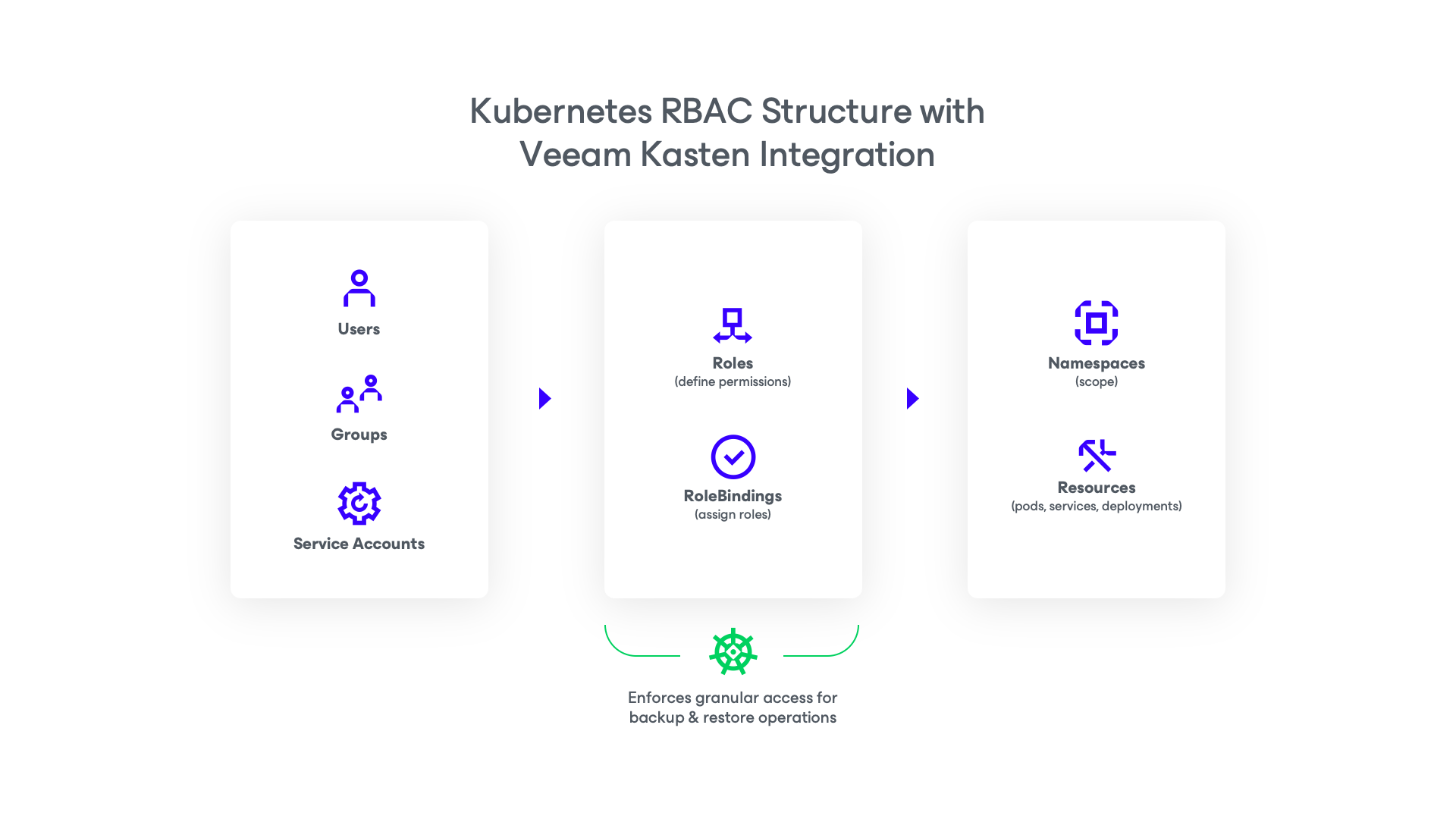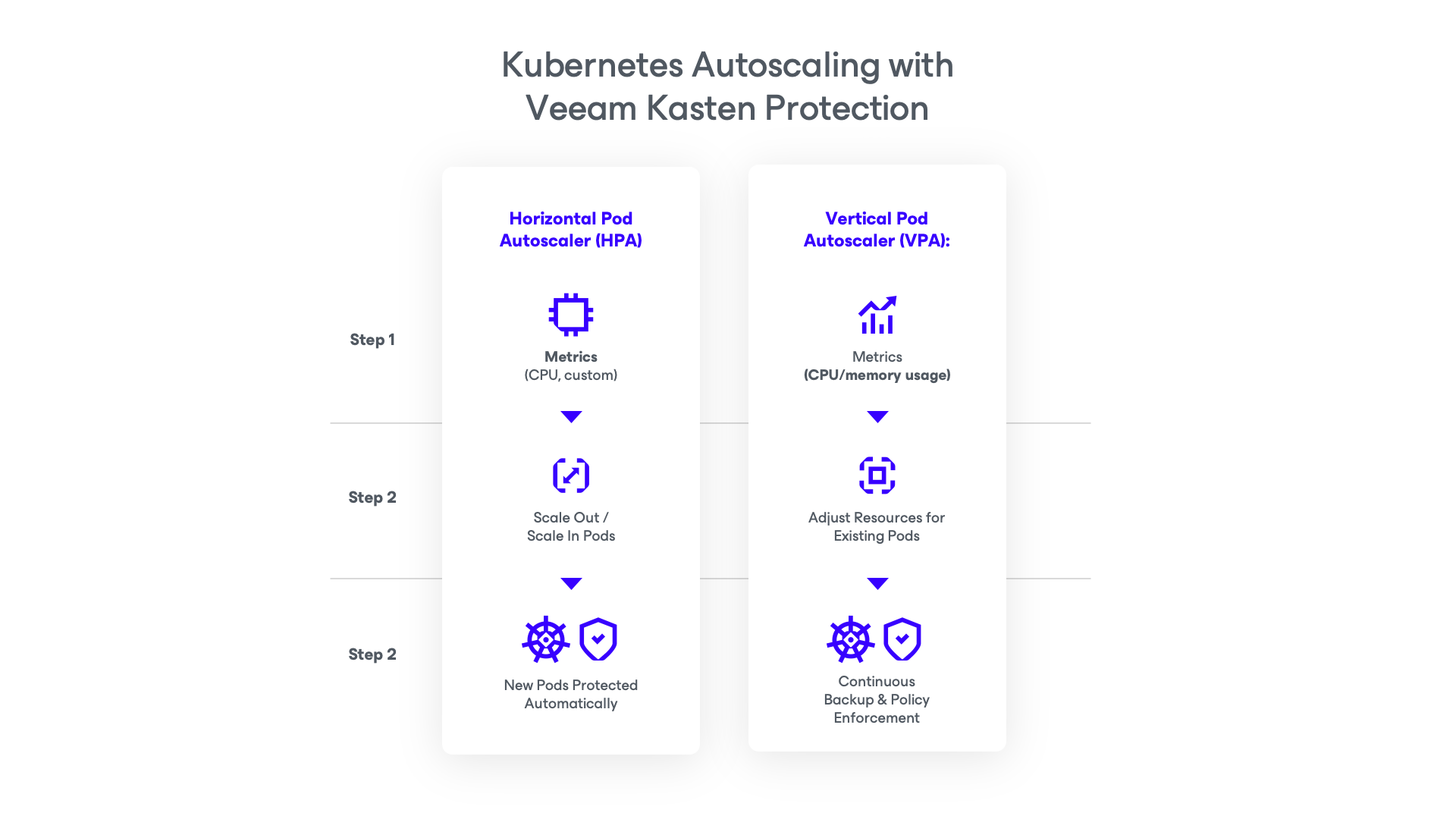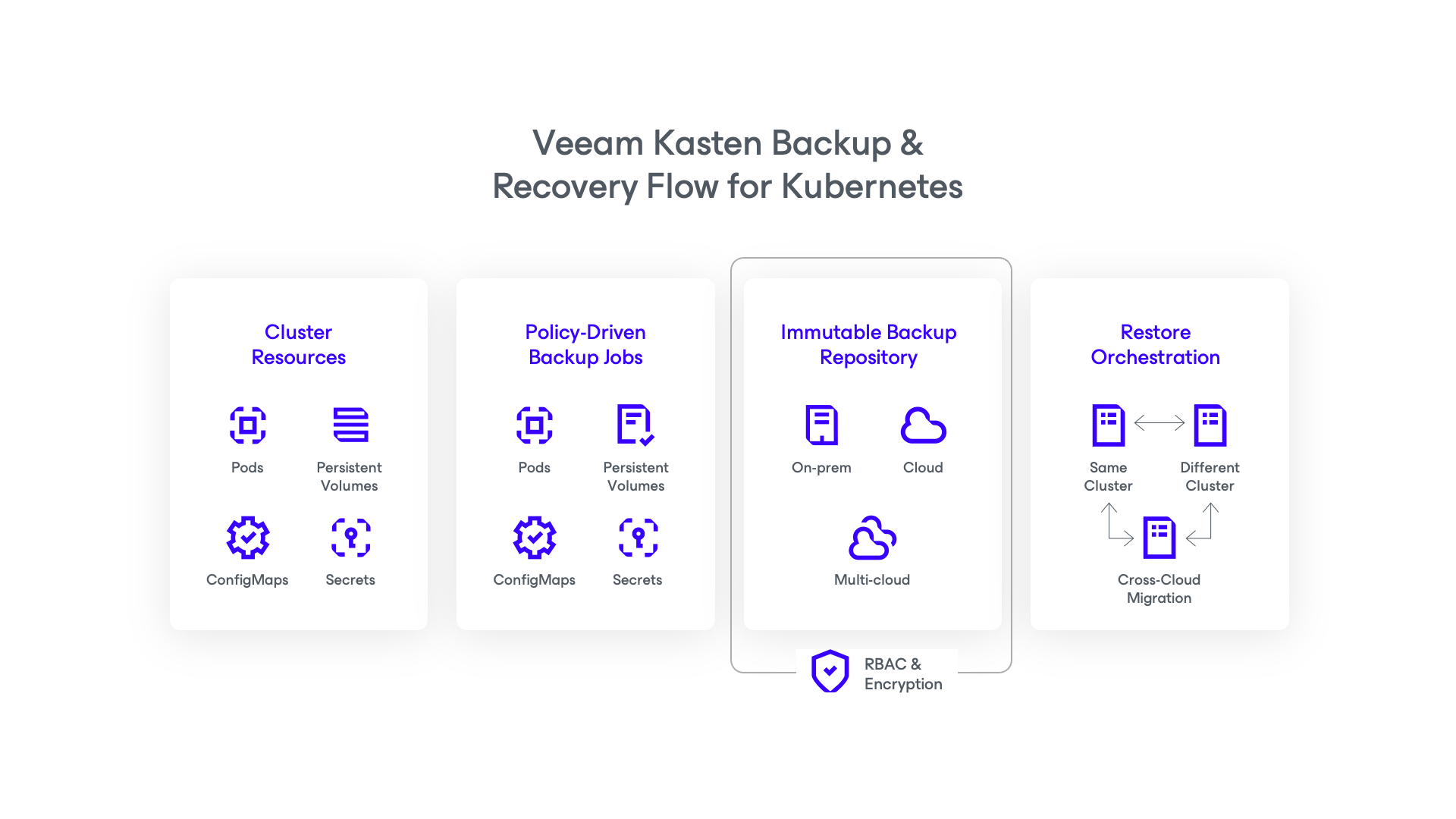Key Takeaways:
- Design for resilience. Use replicas, health checks, and autoscaling to keep workloads available under changing demand.
- Organize effectively. Leverage namespaces, labels, and annotations for clear workload segmentation and easy management.
- Secure from the start. Apply role-based access control (RBAC), network policies, and encrypted secrets to protect workloads and data.
- Monitor and optimize continuously. Use observability tools to track performance, costs, and anomalies.
- Protect your data with policy‑driven backup and disaster recovery (DR).
Kubernetes is the industry standard for orchestrating containerized applications, but running it successfully in production requires more than just deployment skills. You need security, scalability, and data protection built into every layer of your environment.
Best practices like RBAC, network policies, autoscaling, and policy‑driven backups help ensure your clusters are secure, your workloads stay highly available, and your data remains protected across hybrid and multi‑cloud deployments.
That’s where Veeam Kasten comes in. Purpose‑built for Kubernetes, Veeam Kasten delivers application‑aware backup and recovery, DR orchestration, ransomware protection, and seamless workload mobility. It allows you to operationalize these best practices with confidence and automation.
This guide outlines proven steps to help you secure your Kubernetes environment, keep it performing under demand, and safeguard the applications and data your business depends on.
Security Best Practices
1. Implement RBAC
RBAC secures Kubernetes clusters by defining granular permissions for users, service accounts, and groups within a cluster. Assigning specific roles and role bindings ensures that only authorized entities can perform actions on your resources based on their defined roles. This minimizes the risk of unauthorized access or accidental misconfiguration and enforces the principle of least privilege to enhance overall cluster security and governance. However, a common mistake is over-permissioning just to get Kubernetes up and running quickly, and then neglecting to revoke those permissions later. This oversight can leave your deployment exposed. Always review and update permissions regularly to maintain robust security.
Steps to configure RBAC in Kubernetes:
- Define roles: Create roles that specify what actions are allowed within a certain namespace.
- Create RoleBindings: RoleBindings bind roles to users, groups, or service accounts within a specific namespace. RoleBindings associate a role with a set of subjects, which can be users, groups, or service accounts.
- Apply policies: Once roles and bindings are defined, you can apply them to your Kubernetes cluster using kubectl apply. This step ensures that the RBAC policies you’ve defined are enforced across the cluster.
2. Secure Kubernetes API
The Kubernetes API server is the central management point for your entire cluster, which makes it a critical component to secure. Ensure the API server is accessible only over HTTPS to encrypt communications and prevent data interception. Plus, be sure to implement strong authentication mechanisms like client certificates or token-based authentication to verify the identity of users and applications who want to access the API server. Regularly update and patch the API server to address known vulnerabilities and maintain a secure Kubernetes environment too.
To stay current with patches and updates, regularly check the official Kubernetes release notes on GitHub, the Kubernetes Community Forums, and join the kubernetes-security-announce group for emails about security and major API announcements.
3. Network Policies
Network policies control traffic flow between pods and external network endpoints within the cluster. By defining network policies based on labels, namespaces, or IP ranges, administrators can enforce rules that allow or deny communication based on specified criteria. This helps segment and isolate sensitive workloads, prevent unauthorized access, and mitigate potential network-based attacks like denial-of-service (DoS).
An example of a common network policy is Default Deny All that blocks all traffic by default and allows only specific traffic from designated namespaces or pods.
4. Regular Security Audits
Regular security audits identify and remediate security vulnerabilities, misconfigurations, and compliance gaps. Audits should cover aspects such as RBAC configurations, API server security settings, network policies, container runtime security, and adherence to best practices. By continuously evaluating and enhancing security measures, organizations can reduce the risk of security incidents and ensure ongoing protection of Kubernetes deployments against evolving threats.
Users should keep tabs on the Kubernetes CVE library, a valuable community resource that’s updated regularly with Kubernetes vulnerabilities and exposures. The CVE program identifies, defines, and catalogs these vulnerabilities and provides detailed descriptions and unique identifiers for each issue.
5. Ransomware Protection in Kubernetes
Kubernetes workloads, especially those with stateful applications and persistent volumes, are increasingly caught in the crosshairs of ransomware attacks. Threat actors target cluster configurations, container images, and attached storage to encrypt or exfiltrate critical business data. Because containerized workloads are highly dynamic, traditional security and backup tools often fail to provide adequate protection.
To safeguard Kubernetes environments against ransomware, best practices include:
- Immutable backups: Store backups in a write‑once, read‑many (WORM) format so they cannot be altered or deleted by ransomware.
- Isolated recovery environments (e.g., clean rooms): Restore workloads into an isolated Kubernetes cluster to verify data integrity before reintroducing into production.
- Ransomware scanning: Scan backup images for known malware signatures, suspicious patterns, and zero‑day indicators before recovery.
- Granular access control: Enforce RBAC to limit who can initiate backup, delete snapshots, or perform restores.
- Regular recovery testing: Automate recovery drills to ensure workloads can be restored quickly and cleanly in the event of an attack.
How Veeam Kasten Helps
Veeam Kasten delivers enterprise‑grade ransomware resilience for Kubernetes by combining immutable backup repositories, policy‑driven protection, and inline malware scanning using YARA rules. With its application‑aware backup approach, Veeam Kasten ensures that both data and Kubernetes objects like ConfigMaps, Secrets, and Persistent Volume Claims are fully recoverable. During recovery, clean‑room restores and AI‑driven threat detection help validate workloads before they re‑enter production, which minimizes downtime and risk of reinfection.
Performance Optimization
1. Resource Requests and Limits
Set resource requests and limits for CPU and memory at the pod level to ensure pods have adequate resources to operate efficiently without causing contention or resource starvation. Resource requests specify the minimum amount of CPU and memory required by a pod, while limits define the maximum number of resources a pod can consume. Configuring these parameters helps achieve better resource utilization, improve application stability, and avoid performance bottlenecks or resource exhaustion in Kubernetes clusters.
2. Pod Autoscaling
Pod autoscaling in Kubernetes helps manage resource usage more efficiently by adjusting resources based on demand.
Horizontal Pod Autoscaling (HPA) automatically adjusts the number of pod replicas based on observed CPU or custom metric utilization. By defining autoscaling policies, Kubernetes can dynamically alter the number of pod instances up or down in response to changes in workload demand. This ensures that applications can efficiently handle varying levels of traffic to optimize resource utilization and maintain consistent performance without manual intervention. HPA also supports cost-efficiency by scaling resources based on actual usage to enhance responsiveness to workload fluctuations and improve overall application availability.
On the other hand, the Vertical Pod Autoscaler (VPA) automatically adjusts the CPU and memory resources allocated to each pod. This helps right-size applications by dynamically increasing or decreasing resource limits based on actual usage. VPA also improves cluster resource utilization by ensuring each pod has the appropriate amount of CPU and memory, therefore freeing up resources for other pods and enhancing overall cluster efficiency.
3. Monitoring and Logging
Monitoring and logging are essential for maintaining visibility into the health and performance of Kubernetes clusters and applications. Using monitoring tools like Prometheus combined with Grafana dashboards allows administrators to collect and visualize metrics such as CPU usage, memory consumption, and network traffic. Monitoring also helps identify performance issues, detect anomalies, and promptly troubleshoot infrastructure problems. Similarly, integrating centralized logging solutions such as Elasticsearch, Fluentd, and Kibana (EFK stack) or Loki with Grafana ensures comprehensive log aggregation, analysis, and correlation. This proactive approach to monitoring and logging enables timely responses to incidents, enhances performance optimization efforts, and supports the continuous improvement of Kubernetes environments.
4. Optimizing Storage
Effective storage management plays a pivotal role in maximizing performance and scalability within Kubernetes deployments. Using Kubernetes Persistent Volumes (PVs) and Persistent Volume Claims (PVCs) enables applications to access durable storage resources dynamically. Administrators can also enhance storage performance by selecting appropriate storage classes that are tailored to your workload’s requirements and leverage high-performance options such as SSDs or NVMe drives from supported providers. Implementing storage quotas helps prevent resource overallocation and ensures efficient resource utilization. These practices facilitate seamless storage management across various environments, supporting the demands of modern containerized applications and enhancing overall operational efficiency.
Management Best Practices
1. Namespace Management
Effectively managing namespaces is crucial for organizing and isolating workloads within Kubernetes clusters. By logically grouping resources into namespaces, administrators can enforce access controls and resource quotas specifically for different teams or applications. This isolation helps prevent conflicts and simplifies management tasks like monitoring and troubleshooting. Efficient namespace utilization ensures clear visibility and control over resources, thereby enhancing overall cluster governance and operational efficiency. Best practices for namespace management include using separate namespaces for different environments (e.g., development, staging, production) and logical separations (e.g., teams, projects).
2. ConfigMaps and Secrets
ConfigMaps and Secrets store and manage configuration data and sensitive information. ConfigMaps hold configuration data in key-value pairs, which makes it accessible to applications as environment variables or mounted files within pods. Secrets securely store sensitive data like API keys, passwords, and certificates to ensure that only authorized pods can access them. Effective management of ConfigMaps and Secrets is crucial to maintaining the security and configurability of applications across various environments. Adhering to best practices, such as encrypting sensitive data at rest and in transit and regularly rotating secrets, enhances the security and manageability of your Kubernetes applications.
3. Backup and DR
Implementing robust backup and DR strategies is essential for maintaining data integrity and minimizing downtime in Kubernetes environments. Utilizing solutions like Veeam Kasten enables administrators to create consistent backups of cluster resources, such as configurations, persistent volumes, ConfigMaps, Secrets, and application data.
These backups can be stored securely in external locations or cloud repositories, which facilitates quick recovery in the event of data loss or cluster failure. Regularly testing backup integrity and automating recovery processes ensures readiness for unforeseen incidents, safeguards business continuity, and enhances Kubernetes cluster resilience.
CI/CD
Embracing continuous integration and continuous deployment (CI/CD) practices streamlines application development and deployment workflows in Kubernetes as well. Integrating CI/CD pipelines automates build, test, and deployment processes, which enables rapid and reliable application updates. Tools like Jenkins, GitLab CI, or Tekton pipelines facilitate seamless integration with Kubernetes clusters and allow developers to deploy changes efficiently while maintaining consistency and reliability. CI/CD pipelines enhance agility, accelerate time-to-market, and promote collaboration between development and operations teams as well to foster fostering a culture of continuous improvement and innovation within Kubernetes environments.
Additionally, Kanister, an extensible open-source framework used by Veeam Kasten’s platform, enhances this process through Kasten Blueprints. Kanister allows domain experts to capture application-specific data management tasks in Blueprints, which can then be easily shared and extended. This approach speeds up development, minimizes error, and automates Kubernetes deployments to ensure consistent and efficient application management across complex environments.
Veeam Kasten’s Role in Supporting Kubernetes Best Practices
As the industry-leading Kubernetes data protection solution, Veeam Kasten empowers organizations to embrace cloud-native technologies with confidence. This comprehensive platform offers a robust set of features that are designed to safeguard and manage Kubernetes applications and data at scale. Key capabilities include application-aware backup and recovery, DR orchestration, seamless application mobility, and ransomware protection across hybrid and multi-cloud environments.
Veeam Kasten also provides a centralized management console that allows IT teams to streamline data protection operations and ensure consistent policies across their Kubernetes infrastructure. With its deep integrations and support for major cloud providers, Veeam Kasten ensures seamless data protection and application portability regardless of the underlying infrastructure.
Enhancing Security with Veeam Kasten
Veeam Kasten offers features such as RBAC, secure backup, and restore capabilities, including integrations with various security solutions and ransomware protection with immutable backups. With application-aware backups and encrypted data storage, Veeam Kasten ensures that your critical data is safeguarded against unauthorized access and potential breaches.
Veeam Kasten facilitates the secure management of Kubernetes Secrets, ensuring sensitive information remains protected throughout its lifecycle. By integrating seamlessly with Kubernetes RBAC, Veeam Kasten allows administrators to enforce granular access policies, which further enhances the security posture of Kubernetes deployments. These capabilities help organizations maintain a robust security posture while simplifying the management of their Kubernetes environments.
Optimizing Performance with Veeam Kasten
Veeam Kasten provides tools and features to optimize the performance of Kubernetes deployments. With deep visibility through comprehensive monitoring and logging, including integrations with Prometheus and Grafana, organizations can proactively make performance adjustments. Veeam Kasten also minimizes downtime with efficient backups and restores to ensure your applications remain responsive. Intelligent data management policies further enhance resource utilization through automated scheduling and allocation.
Veeam Kasten also supports integrations with Datadog for advanced monitoring and SIEM systems for enhanced security and compliance. By integrating with high-performance storage and supporting dynamic scaling, Veeam Kasten enables organizations to manage fluctuating workloads effectively, ensuring a reliable, high-performing Kubernetes environment.
Simplifying Management with Veeam Kasten
Kubernetes environments can be notoriously complex to manage. Veeam Kasten tackles this challenge head-on by offering a suite of automated features, including backups, DR, and CI/CD integration. This not only streamlines operations and reduces manual workload for administrators, but ensures the availability and resilience of your deployments too.
Veeam Kasten’s intuitive interface and policy-driven automation simplifies even the most intricate tasks like backup and migration. The platform also empowers proactive management through real-time insights from its comprehensive monitoring capabilities. In the event of disaster, Veeam Kasten’s fast and reliable recovery processes minimize downtime and data loss, ensuring business continuity.
By combining Kubernetes best practices with Veeam Kasten’s enterprise‑grade backup, DR, and security features, you ensure your clusters are ready for anything from scaling demands to ransomware threats.
Turn Kubernetes Best Practices into Action with Veeam Kasten
Explore the full capabilities of Veeam Kasten for Kubernetes, the enterprise‑grade solution for backup, DR, and application mobility in cloud‑native environments. See how to protect stateful workloads, implement immutable backups, and recover quickly from any disruption.
FAQs
1. What are the top Kubernetes best practices for beginners?
Focus on security first with RBAC, secure API access, and network policies to protect workloads. Use namespaces to separate environments, set resource requests and limits to prevent noisy neighbors, and enable autoscaling to handle traffic changes. Monitor with Prometheus and Grafana, and always implement a backup and DR plan so you can recover quickly if something breaks.
2. How do I secure a Kubernetes cluster?
Think “layers of defense”. Use RBAC for permissions, encrypt data at rest and in transit, lock down the API server, and isolate workloads with network policies. Rotate secrets often and run regular security scans to catch misconfigurations before attackers can take advantage.
3. What’s the best way to organize workloads in Kubernetes?
Namespaces let you separate dev, test, and production on different teams. Apply resource quotas to prevent one app from draining resources. Keep configs clean and portable with ConfigMaps and Secrets instead of hardcoding values into your apps.
4. How can I scale Kubernetes applications efficiently?
Use Horizontal Pod Autoscaler for traffic surges, Vertical Pod Autoscaler for right-sizing workloads, and Cluster Autoscaler to adjust nodes automatically. Pair this with load balancing so your apps stay performant without wasting resources.
5. What tools are recommended for monitoring Kubernetes?
Prometheus for metrics, Grafana for dashboards, Loki or the EFK stack for logging, and Falco for runtime security. Add alerting so issues reach you before users notice.
6. How do I back up Kubernetes workloads?
Choose a Kubernetes-native backup solution that protects apps, persistent volumes, and configs together. Follow the 3-2-1 backup rule, which means having three copies of your data, on two types of media, with one stored offsite. This ensures recovery even from ransomware or cluster failures.




